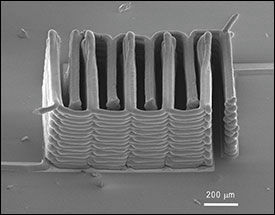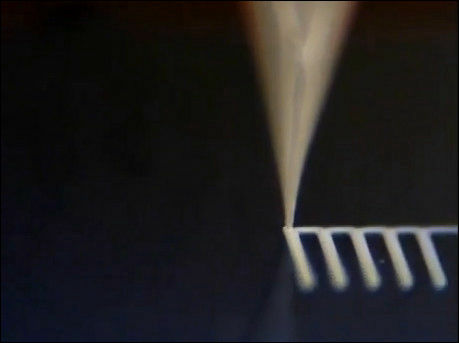Minimal battery created by printing electrodes thinner than hair with a 3D printer

Together with the development of technology, ultra-small electronic devices are used in medical and scientific fields. However, in order to supply electric power to ultra-small electronic devices, there was a problem that we had to develop a battery that was smaller than ultra-small electronic devices. I was pursuing research to solve this problemHarvard UniversityWhenUniversity of Illinois at Urbana-ChampaignJoint research team has finally announced that it succeeded in creating a miniature battery of the same size as the sand grain with a 3D printer.
Printing Tiny Batteries: Wyss Institute at Harvard
http://wyss.harvard.edu/viewpressrelease/114/
The joint research team of Harvard University and the University of Illinois at Urbana-Champaign accurately overlays electrodes thinner than human's hair using a 3D printer in order to create a micro battery that is as large as sand grains Adopted the technique.
The image below is where the anode and cathode of the microbattery electrode are stacked one after another and are being printed by a 3D printer.

Manufacturers were also developing to create batteries compatible with ultra-miniaturized devices, but even with the creation of extremely small size batteries the power enough to supply sufficient power to microelectronic devices There was a problem that there was nothing. Researchers who understand that this problem can not be solved unless electrodes of ultra-thin batteries are accurately stacked overlap one another in 3D printers and print while stacking inks That's why I took a look at the technique.
You can check how the electrode of the micro battery is printed using the 3D printer from the following movie.
Tiny 3D-Printed Battery on Vimeo
A research team that overcame the wall that it is necessary to create an extremely small electrode stacked accuratelyInk materialI will confront the next task. The ink for making the battery must be a material that is like a toothpaste from the nozzle of the 3D printer and it is a substance that works properly electrochemically as it is a material for the anode and the cathode I could not do it.

In order to solve the problem of ink, the research team developed an ink containing lithium metal oxide of nanoparticles at the anode of the electrode. After that, we succeeded in making a very small size battery by filling the electrode made with the developed ink into a small container and filling it with electrolyte solution.

According to researchers, the ability to create ultra-compact batteries through the invention of innovative ink greatly broadens the possibilities of 3D printing and greatly contributes not only to medical treatment but also to miniaturization of devices in other fields It is said that.
Related Posts:







